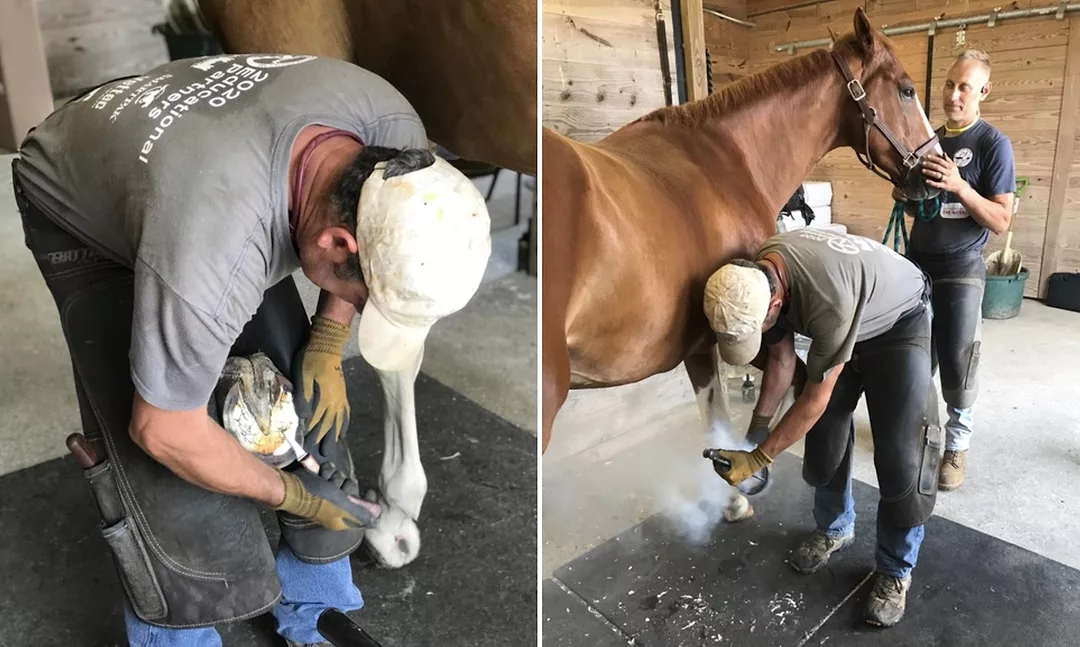"We joke and say it's the world's second oldest profession," Ike Birdsall, owner of Birdsall's Hotshoe, a farrier based in Sag Harbor, N.Y., tells the East Hampton Star.
Farriers are an essential but unheralded segment of the $122 billion horse industry. The job hasn't changed substantially since 400 B.C. when the earliest horseshoes, a combination of rawhide and leather, were made.
Well, maybe it's changed a little. The Hampton Classic, the annual weeklong horse show in Bridgehampton, N.Y., wasn't a thing back then. And horseshoes weren't mass-produced until 1835.
Ike Birdsall was born into the profession; his father, David Birdsall, was a farrier and his uncle was a farrier at the Saratoga Racetrack. His father started the business in 1969. Ike took it over in 2006. The elder Birdsall was also inducted into the International Horseshoeing Hall of Fame in 2008.
"I like animals. Even when you get beat up," Ike says.
"We did the Classic for 24 years, 12 hours a day," says Birdsall. "Every horse that stepped up was a horse we didn't know. I watched my father get stomped by a horse named Surf there. I never looked forward to it. It's horses you're going to work on once and never see again." Birdsall says it is hard to build a relationship with those horses or clients. Still, it's important to try to build trust with any horse you're working on.
Gaining a horse's trust sometimes takes years. "The best way to bond with your horse is to rub him, walk him in the field," says Birdsall.
One of Birdsall's oldest accounts is the Swan Creek Horse Farm in Bridgehampton, where about 40 horses reside. The Birdsall family has been shoeing horses there since 1971. On a recent day, he and Berkoski, who has worked with Mr. Birdsall for over 20 years, were shoeing horses ahead of the Hampton Classic. One of the benefits of holding this account for so long, Birdsall says, is that the horses have come to trust him.
While plenty of farriers "follow the horses," Birdsall, and his partner, Craig Berkoski, are perhaps the only farriers still living full-time on the South Fork, on New York's Long Island. "We know guys who fly in from France and do 50 to 60 horses and then leave," he says. "But that's not our business. There's more guys following the horses now then there were in the '80s or '90s." Living near the Hampton Classic's base of operations benefits Birdsall and Berkoski, as they can work for the horses in the show.
“Sometimes while one man works on the shoes, the other is forced to stroke the head of the horse, to quiet the situation down,” says Berkoski. "We make it pretty nice for them," he says as a fan blows fresh air toward a horse held in a stall by two cross ties.
Berkoski barely took notice as the horse lightly mouthed the top of his head. From outside the barn window, a song sparrow sang. As peaceful as it felt, a bite from a black fly could have upended everything. A farrier learns that the first step to shoeing a horse is applying fly spray.
Working in two adjacent stalls, the men don't say much. The sounds of their labor take precedence.
A horse named Gatsby looked on impassively as Berkoski ran a rasp across the rounded surface of its hoof. Taking a caliper out of his apron, Berkoski remeasured the hoof. In the next stall, Mr. Birdsall was nailing shoes on another horse.
The farriers, operating at different speeds, go from the stalls to the truck. Once the hooves are trimmed, they grind and level the shoes that can be reused. The shoes are removed, placed on the anvil, scraped with a wire brush, and then put back in the forge. Once the hot set is completed and after the shoe is cool, the men drill threaded holes into it. This gives the groom the option of adding traction, by way of a type of threaded bolt, for jumping.
"Most horses at the Classic need traction," says Berkoski. Finally, they nail the shoe back on, putty the holes, and paint on a sealant called Farrier Barrier, a product created by Ike's father.
While the world changes around them, the stall feels timeless.
"You're not worried about artificial intelligence taking over," Birdsall says. "I don't think that's going to work."
This article was originally published by The East Hampton Star, and is republished with permission.







